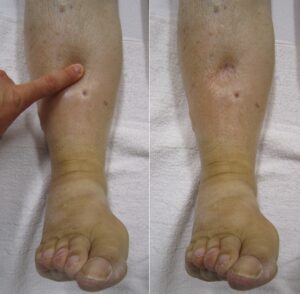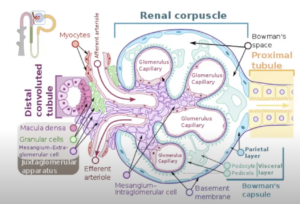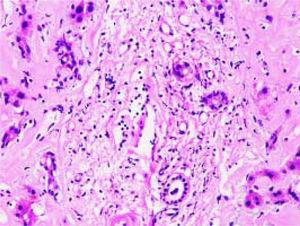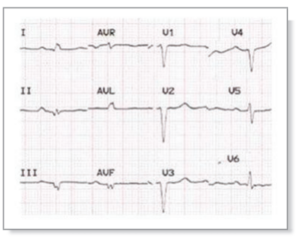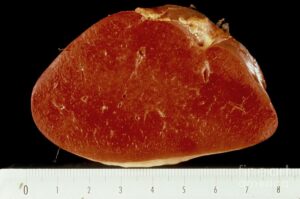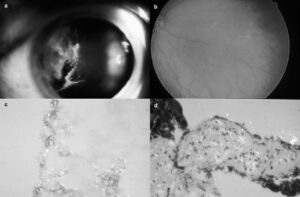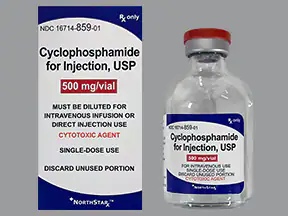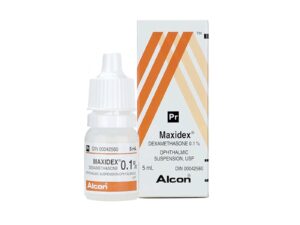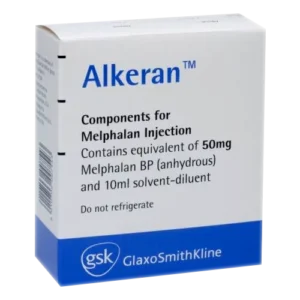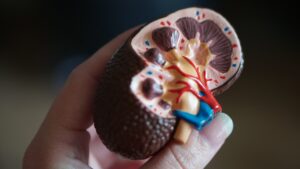AL (Primary) Amyloidosis
Chest Pain (Cardiac Amyloidosis)
Chest pain is a frequent symptom in patients with cardiac amyloidosis (CA) and is associated with a more advanced cardiac impairment. [source: International Journal of Cardiology]
Shortness of breath when lying flat (Orthopnea)
People with more severe heart failure may experience shortness of breath when they lie down. The medical term for this symptom is orthopnea (say “or-THAWP-nee-uh”). The severity of this symptom usually depends on how flat you are lying—the flatter you lie, the more you feel short of breath.
Frothy/Bubbly Urine (Kidney Damage)

Foamy urine is a sign of protein in the urine, which is not normal. “Kidneys filter the protein, but should keep it in the body,” explains Dr. Ghossein. If kidneys are releasing protein into the urine, they are not working properly.
Fluid Swelling (Peripheral Edema) hands, legs or feet
If the amyloidosis affects the kidneys, their ability to filter the blood becomes impaired. Protein leaks from the blood into the urine. The loss of protein from the blood can cause fluid to leak out of the blood vessels, resulting in swelling in the feet, ankles and calves.
Protein in the Urine (Nephrotic Syndrome)
Nephrotic syndrome is usually caused by damage to the clusters of small blood vessels in your kidneys that filter waste and excess water from your blood. The condition causes swelling, particularly in your feet and ankles, and increases the risk of other health problems.
Enlarged Liver – Primary Hepatic Amyloidosis (PHA)
Primary hepatic amyloidosis (PHA) is characterized by abnormal deposition of monoclonal immunoglobulin light chains (AL) in the liver. This rare condition is frequently undiagnosed or misdiagnosed and can be associated with poor prognosis. At present, the precise pathogenesis is not fully understood.
Infrequent Urination (Kidney damage)
Most commonly, amyloid deposits build up in the heart and kidneys. Roughly 70% of patients have involvement with either of these organs, notes Dr. Weiss.
Weight Loss / Loss of Appetite (Kidney Damage / Gastrointestinal Amyloidosis)
Low QRS voltages (LQRSVs) (Cardiac Amyloidosis)
Typical ECG of a patient with cardiac AL amyloidosis showing low QRS voltages in the limb leads and pseudoinfarction pattern in the chest leads. (from Updates in Cardiac Amyloidosis: A Review; Banypersad S et al; J Am Heart Assoc 2012)
Tingling Sensation in the Hands and Feet (Amyloid Neuropathy)
Peripheral neuropathy is a common manifestation of AL amyloidosis, and the incidence of peripheral neuropathy in AL amyloidosis varies from 9.6 to 35% (3–5). The typical pattern of amyloid neuropathy is symmetrical, length-dependent, lower-limb predominant, slowly progressing polyneuropathy, with severe pain. [source: NIH]
- NIH: Light-Chain Amyloidosis With Peripheral Neuropathy as an Initial Presentation
- Video: Neurological Manifestations of Amyloidosis
- Light-Chain Amyloidosis With Peripheral Neuropathy as an Initial Presentation
- Video: ARC Talks: Amyloid Neuropathy Burden and Management
- Video: Peripheral Neuropathy and Amyloidosis – Part 01
- Video: Peripheral Neuropathy and Amyloidosis – Part 02
Diarrhea / Constipation (Gastrointestinal Amyloidosis)
Enlarged Tongue (Macroglossia) – Sometimes with rippled edges
An enlarged tongue (macroglossia) can be a sign of amyloidosis. It can sometimes also appear rippled along its edge.
Purple lesions on the skin (Purpura)
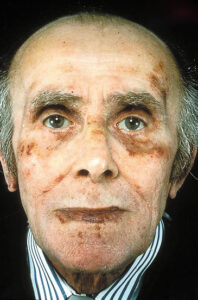
Spleen
While amyloidosis may be systemic or localized, splenic involvement is fairly common (5–10%) and generally asymptomatic [3]. When splenic rupture secondary to localized amyloidosis occurs, it is usually the first manifestation of the disease process. This case illustrates spontaneous splenic rupture due to localized amyloidosis as an important consideration in the differential of acute abdominal pain. It also highlights amyloidosis as a potential marker for other systemic disease that may only be recognized or investigated after splenic pathology is elucidated.
Fatigue (Cardiac Amyloidosis / General Organ Stress)
When amyloid proteins overwhelm your organs, you may not have the energy and strength you once had. Amyloidosis can cause severe, unusual fatigue. You may not feel up to doing the activities you once enjoyed. You may even need frequent naps during the day. [source: healthline]
Primary nonfamilial ocular amyloidosis
Ocular amyloidosis is a rare cause of vitreous haze1,2 and should be included in the differential diagnosis of vitreous opacification. The ophthalmologist should be aware that ocular amyloidosis may occur sporadically and that vitreous biopsy with specific staining with Congo red dye may be indicated.
Carpal Tunnel Syndrome (Amyloid Neuropathy)
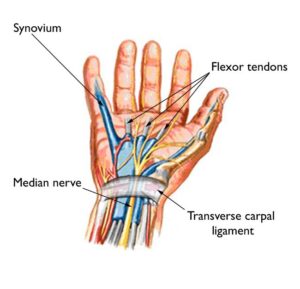
In patients undergoing surgery for idiopathic CTS, a recent study identified amyloidosis by tenosynovial biopsy in 10.2% of men older than 50 years and women older than 60 years; all positive patients had bilateral symptoms. [source: NIH]
Standard Treatment: A medical Cocktail
What you can expect. If you have been diagnosed with AL amyloidosis the standard chemotherapy treatment in the United States consists of a 4 drug combination of subcutaneous daratumumab, bortezomib, cyclophosphamide, and dexamethasone.
Bortezomib (VELCADE®)
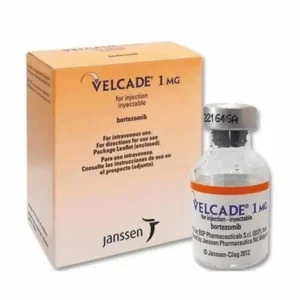
VELCADE (bortezomib) is a type of chemotherapy called a targeted therapy.
VELCADE belongs to a class of medicines called proteasome inhibitors. It is approved by the FDA for the treatment of multiple myeloma and mantle cell lymphoma. VELCADE has been studied in many important clinical trials. It has been studied in a wide range of people, including those with renal impairment and diabetes. As a targeted therapy, VELCADE works by blocking or slowing down the action of proteasomes inside cells. The function of proteasomes is to break down proteins in both healthy and cancerous cells.
- Website
- Takeda Patient Support 1-866-861-1750, Monday through Friday, 8 AM to 8 PM ET.
- Treatment Guide
- Financial Assistance Guide
- VIDEO: CVS Specialty services for patients taking Velcade
Cyclophosphamide (Cytoxan®, Neosar®)
Dexamethasone (Ozurdex, Maxidex)
The use of cyclophosphamide (Cy), bortezomib (Bor), and dexamethasone (D), the CyBorD regimen, to treat AL amyloidosis, caused by a non-immunoglobulin M (IgM) monoclonal gammopathy, has significantly improved survival outcomes [10]: CyBorD results in a complete hematologic response of 71% and a 1-year OS of 65%
Melphalan (Alkeran)
Melphalan belongs to the group of medicines called alkylating agents (cancer medicines). It works by interfering with the growth of cancer cells, which are eventually destroyed by the body. Since the growth of normal cells may also be affected by melphalan, other unwanted effects will also occur.
Daratumumab (Darzalex®)
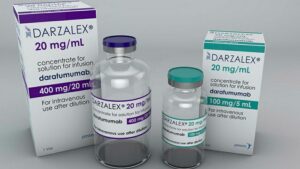
Daratumumab is an anti-cancer monoclonal antibody medication. It binds to CD38, which is overexpressed in multiple myeloma cells. In May 2018, the U.S. Food and Drug Administration (FDA) approved daratumumab for use in combination with bortezomib, melphalan and prednisone to include the treatment of people with newly diagnosed multiple myeloma who are ineligible for autologous stem cell transplant. [source:wikipedia]
- How do you pronounce “Daratumumab”?
- VIDEO: Understanding Darzalex Faspro
- Financial Assistance
- Janssen CarePath Care Coordinator (844) 553-2792
Bone Marrow / Stem Cell Transplant
Stem cell transplantation (SCT) is an effective treatment for amyloidosis , but it’s not a cure. Amyloidosis will return in everyone. However, some patients have been successfully treated with SCT and have been able to receive another SCT when their disease progressed.
- UChicago Medicine – Treating Cardiac Amyloidosis
- VIDEO: Amyloidosis – diagnosis and stem cell transplantation
- The Role of Autologous Stem Cell Transplantation in Amyloidosis
- Stem-cell Mobilization and Autologous Transplant for Immunoglobulin Light Chain Amyloidosis
- Social Wall: Chemotherapy and Bone Marrow Transplant
- Social Wall: 12 months post Bone Marrow Transplant
Care Team Basics
Studies have found that patients who receive care from a coordinated care team have better health outcomes, including lower rates of hospitalization and mortality. They also have higher rates of satisfaction with their care.
A care team is a group of healthcare professionals who work together to provide care for a patient. The care team may include doctors, nurses, therapists, social workers, and other specialists. The team works together to develop a plan of care and coordinate services.
Care Team Coordinator
A care coordinator is a health care professional responsible for managing patient care by monitoring treatment plans, educating patients on their conditions, and connecting them to relevant health care providers.
Cardiologist (Heart)
A cardiologist is a physician who’s an expert in the care of your heart and blood vessels. They can treat or help you prevent a number of cardiovascular problems. They can also specialize in specific areas, such as abnormal heart rhythms, heart failure or heart problems you’ve had since birth. [source: Cleveland Cllinic]
Nephrologist (Kidneys)
A nephrologist is a medical doctor who specializes in kidney care and treating diseases of the kidneys. The term nephrologist comes from the Greek word “nephros”, which means kidney or renal and “ologist” refers to someone who studies. Nephrologists are also called kidney doctors.
Oncologist (Cancer)
Oncology is the study of cancer. An oncologist is a doctor who treats cancer and provides medical care for a person diagnosed with cancer. An oncologist may also be called a cancer specialist. The field of oncology has 3 major areas based on treatments: medical oncology, radiation oncology, and surgical oncology.
Hematologist (Blood)
Hematologists and hematopathologists are highly trained healthcare providers who specialize in diseases of the blood and blood components. These include blood and bone marrow cells. Hematological tests can help diagnose anemia, infection, hemophilia, blood-clotting disorders, and leukemia. [source: Hopkins Medicine]
Neurologist (Brain & Nervous System)
A neurologist is a medical doctor with specialized training in diagnosing, treating, and managing disorders of the brain and nervous system including, but not limited to, Amyloidosis, Alzheimer’s disease, amyotrophic lateral sclerosis (ALS), concussion, epilepsy, migraine, multiple sclerosis, Parkinson’s disease, and stroke.
Immunologist (Immune System)
Immunologists are research scientists or practicing specialists who study, analyze and/or treat disease processes that involve the immune system.
Pulmonologist (Respiratory System/Lungs)
A pulmonologist is a physician who specializes in the respiratory system. From the windpipe to the lungs, if your complaint involves the lungs or any part of the respiratory system, a pulmonologist is the doc you want to solve the problem.nPulmonology is a medical field of study within internal medicine. [source: American Lung Association]
Psychologist (Emotional Wellbeing)
A psychologist is a mental health professional who uses psychological evaluations and talk therapy to help people learn to better cope with life and relationship issues and mental health conditions. [source: Cleveland Clinic]
Social Worker
Social workers assist a range of patient populations and provide services in areas including mental health conditions and addictions, chronic disease, children and youth illnesses, geriatrics illnesses, grief, trauma, parenting issues, palliative care, dementia and other neurological issues, financial stressors, housing issues and a broad range of other general psychosocial issues (Ashcroft et al. 2018; McGregor et al. 2018; Sverker et al. 2017).
AL Clinical Trials
Research
Stay Up To Date:
Featured Resources

Caregiver Support : Taking care of yourself





